Abstract
Survival rates for burn patients in general have improved markedly over the past several decades. The development of topical antibiotic therapy for burn wounds, the institution of the practice of early excision and grafting, and major advances in intensive care management have all contributed to this success. In this review we address these 3 important advances in the modern treatment of burn injuries and provide a brief historical overview of these accomplishments and others, emphasizing specific achievements of note and promises for the future. We also discuss 3 topics of interest to burn physicians, including the special problems and high mortality of elderly burn patients, the disturbingly high mortality in burn patients with inhalation injury, and the possible use of artificial skin to facilitate rapid wound closure.
Full text
PDF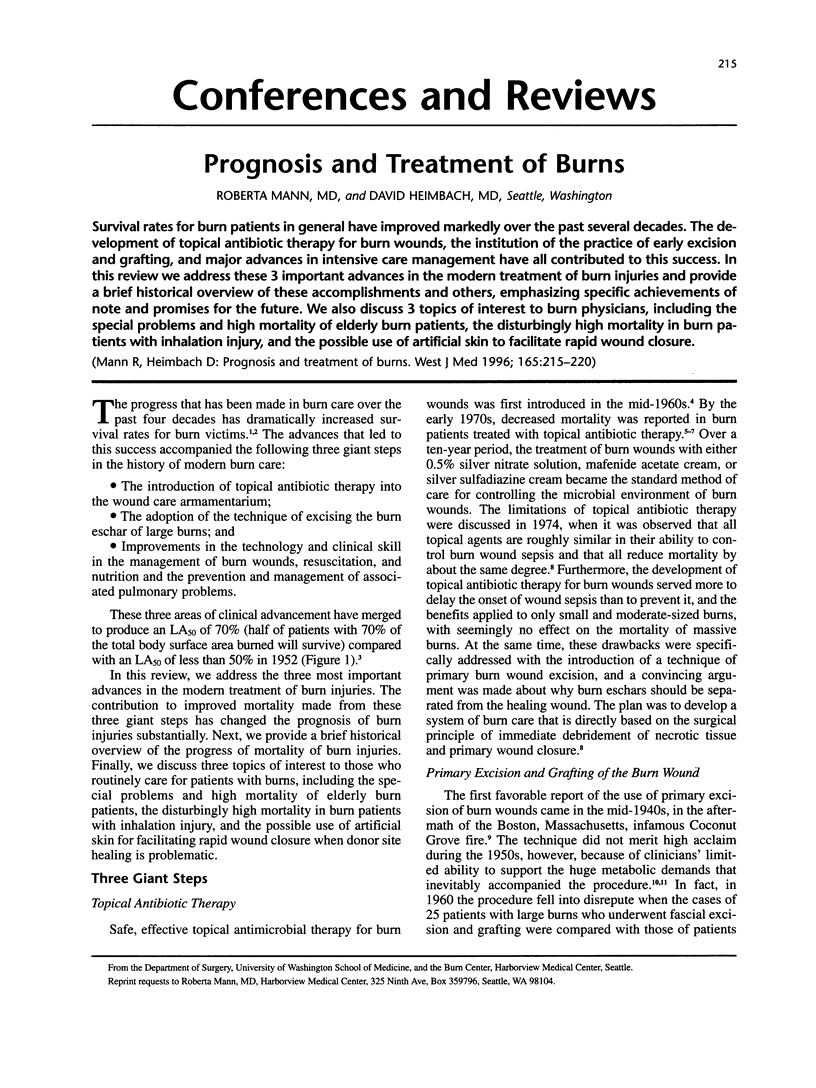
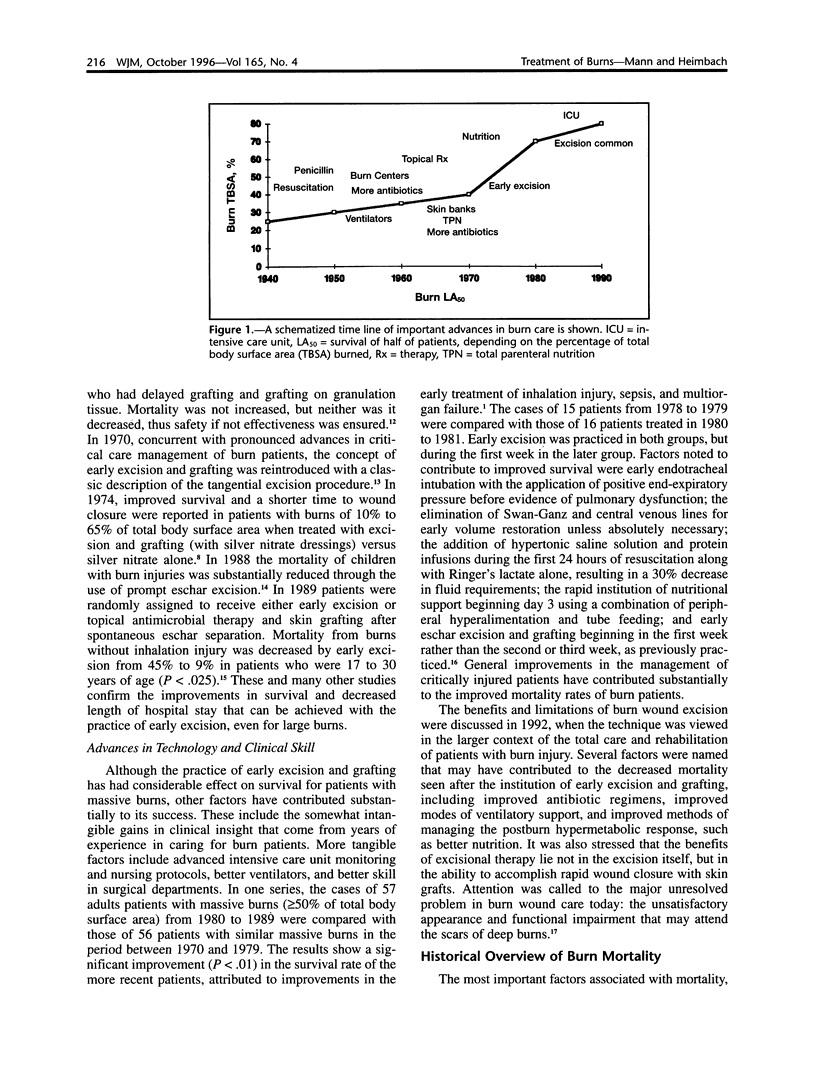
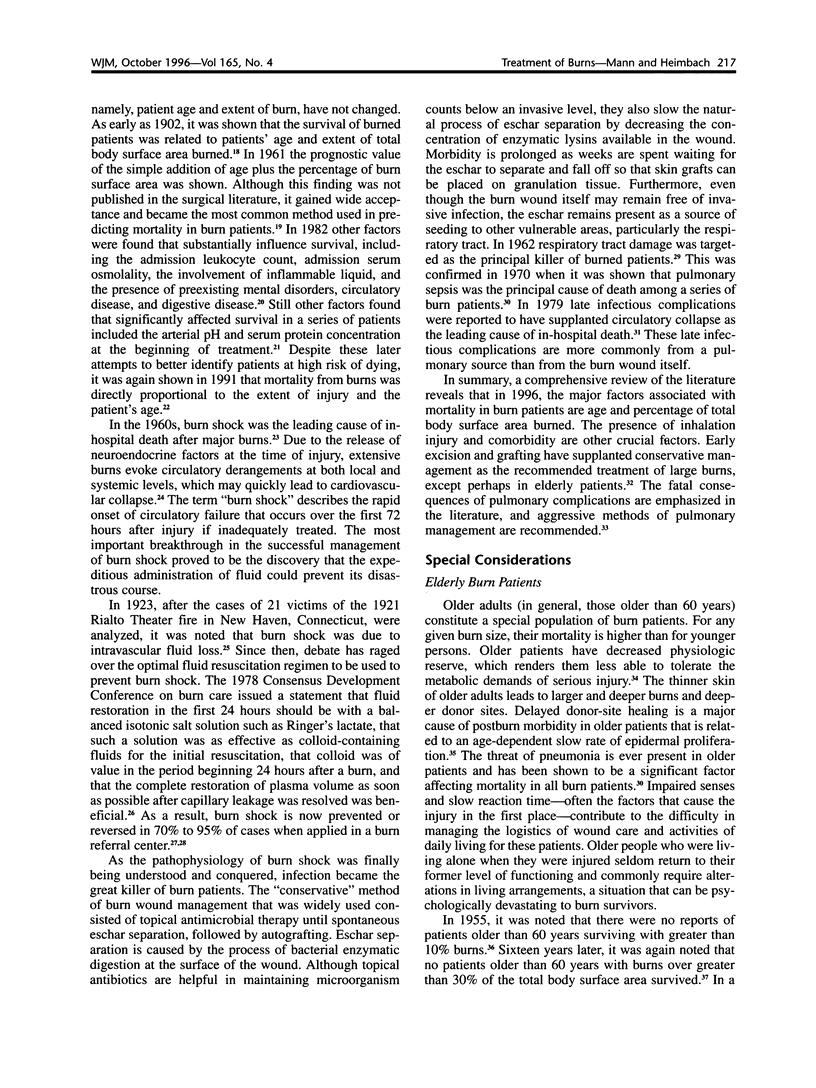
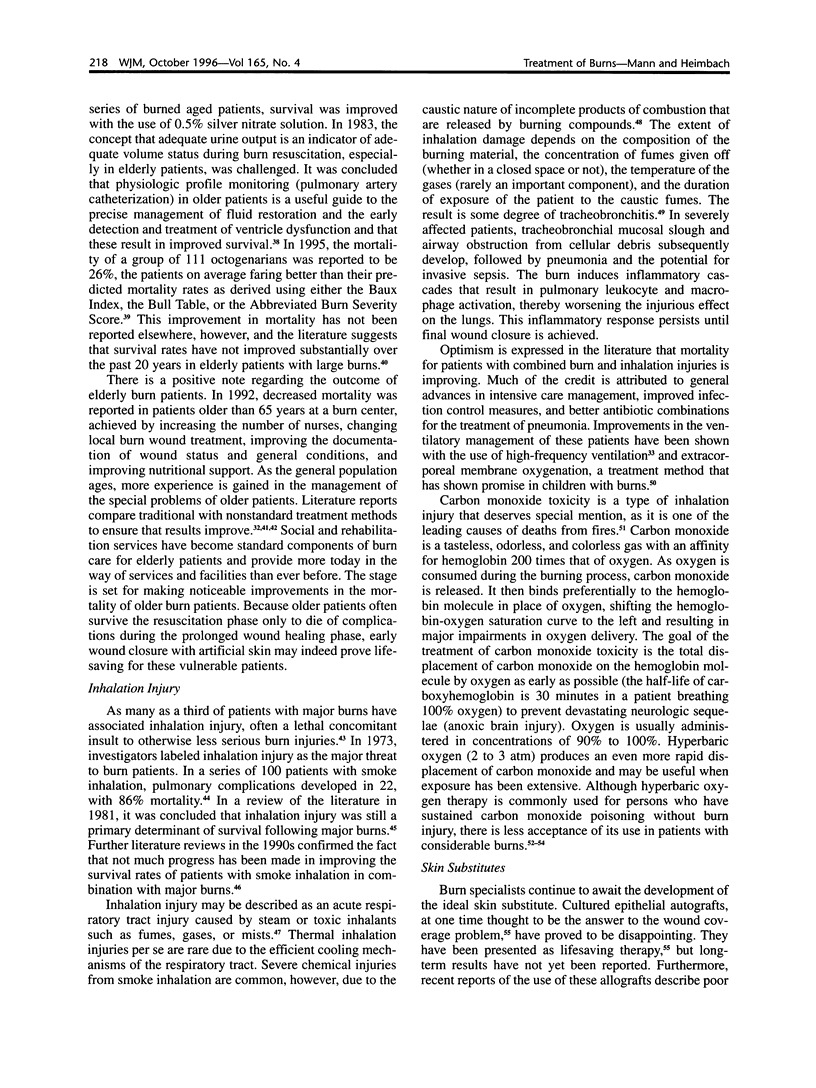
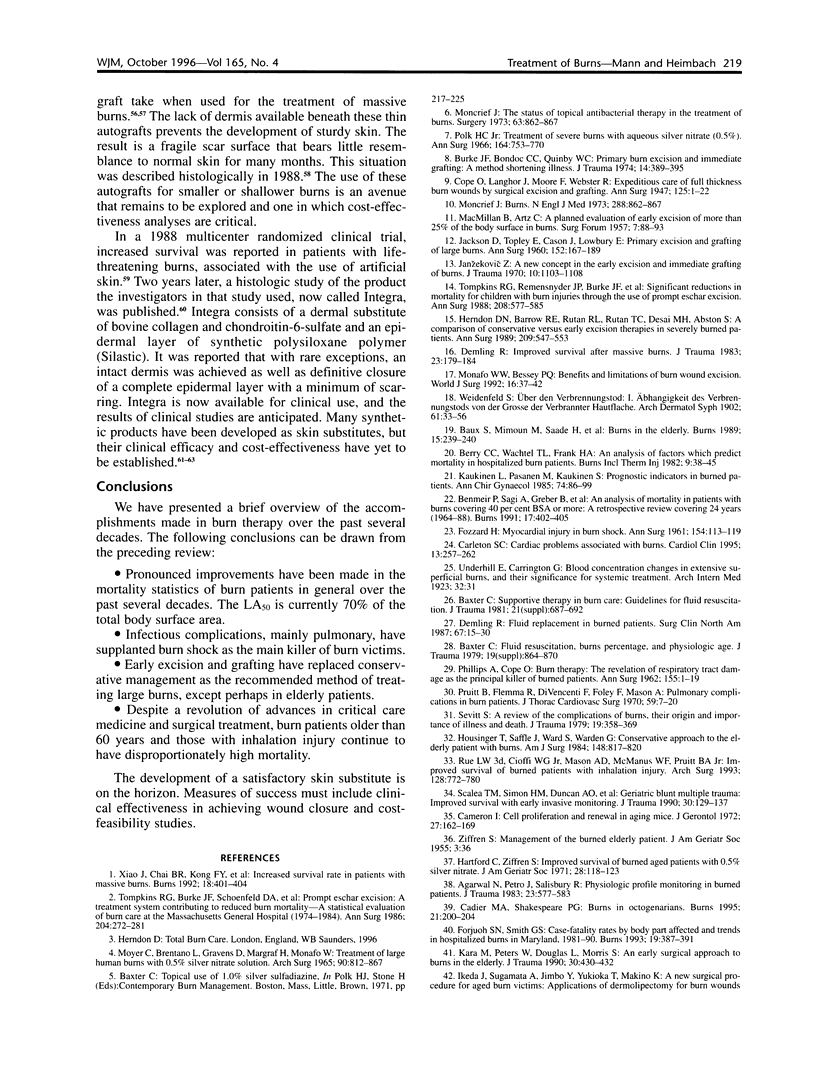
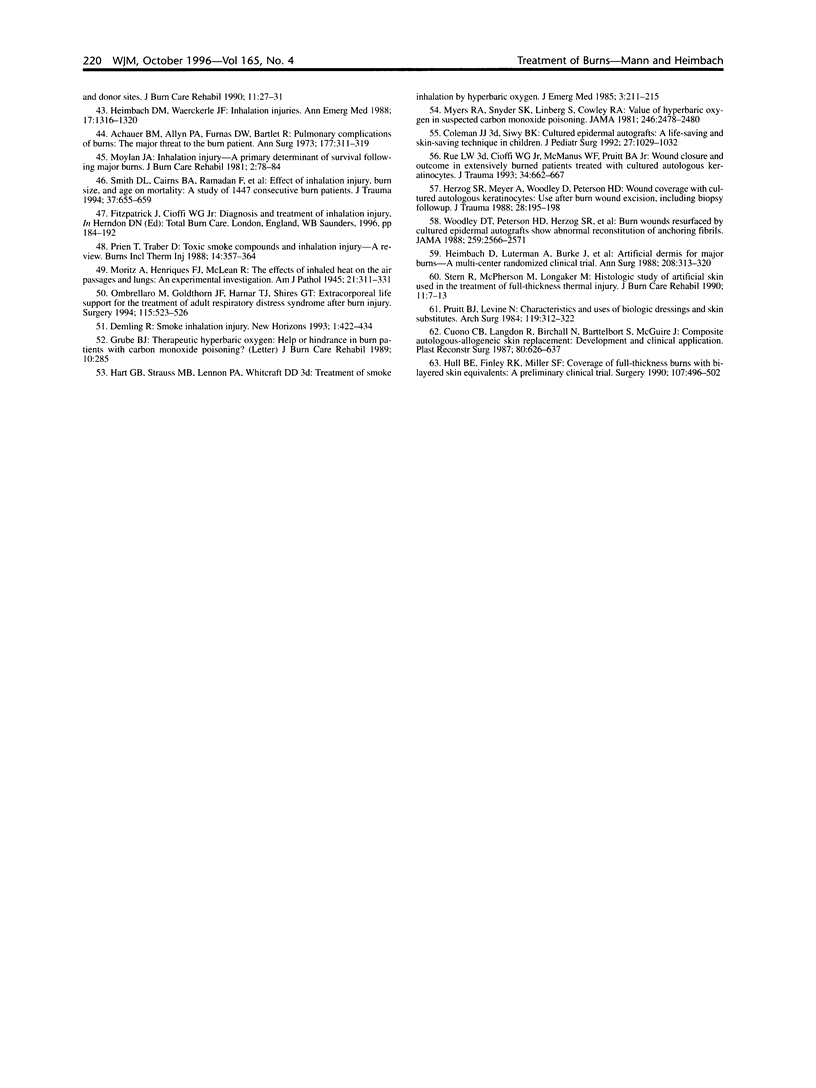
Selected References
These references are in PubMed. This may not be the complete list of references from this article.
- Achauer B. M., Allyn P. A., Furnas D. W., Bartlett R. H. Pulmonary complications of burns: the major threat to the burn patient. Ann Surg. 1973 Mar;177(3):311–319. doi: 10.1097/00000658-197303000-00012. [DOI] [PMC free article] [PubMed] [Google Scholar]
- Agarwal N., Petro J., Salisbury R. E. Physiologic profile monitoring in burned patients. J Trauma. 1983 Jul;23(7):577–583. doi: 10.1097/00005373-198307000-00006. [DOI] [PubMed] [Google Scholar]
- Baux S., Mimoun M., Saade H., Lioret N., Esteve M., Nolland X. B., Bertiere M. N. Burns in the elderly. Burns. 1989 Aug;15(4):239–240. doi: 10.1016/0305-4179(89)90039-9. [DOI] [PubMed] [Google Scholar]
- Baxter C. Fluid resuscitation, burn percentage, and physiologic age. J Trauma. 1979 Nov;19(11 Suppl):864–865. [PubMed] [Google Scholar]
- Benmeir P., Sagi A., Greber B., Vardy D., Lusthaus S., Picard E., Baruchin A., Hauben D., Ben-Yaqar Y., Rosenberg L. An analysis of mortality in patients with burns covering 40 per cent BSA or more: a retrospective review covering 24 years (1964-88). Burns. 1991 Oct;17(5):402–405. doi: 10.1016/s0305-4179(05)80075-0. [DOI] [PubMed] [Google Scholar]
- Berry C. C., Wachtel T. L., Frank H. A. An analysis of factors which predict mortality in hospitalized burn patients. Burns Incl Therm Inj. 1982 Sep;9(1):38–45. doi: 10.1016/0305-4179(82)90134-6. [DOI] [PubMed] [Google Scholar]
- Burke J. F., Bondoc C. C., Quinby W. C. Primary burn excision and immediate grafting: a method shortening illness. J Trauma. 1974 May;14(5):389–395. doi: 10.1097/00005373-197405000-00005. [DOI] [PubMed] [Google Scholar]
- Cadier M. A., Shakespeare P. G. Burns in octogenarians. Burns. 1995 May;21(3):200–204. doi: 10.1016/0305-4179(95)80009-d. [DOI] [PubMed] [Google Scholar]
- Cameron I. L. Cell proliferation and renewal in aging mice. J Gerontol. 1972 Apr;27(2):162–172. doi: 10.1093/geronj/27.2.162. [DOI] [PubMed] [Google Scholar]
- Carleton S. C. Cardiac problems associated with burns. Cardiol Clin. 1995 May;13(2):257–262. [PubMed] [Google Scholar]
- Coleman J. J., 3rd, Siwy B. K. Cultured epidermal autografts: a life-saving and skin-saving technique in children. J Pediatr Surg. 1992 Aug;27(8):1029–1032. doi: 10.1016/0022-3468(92)90552-i. [DOI] [PubMed] [Google Scholar]
- Cope O., Langohr J. L., Moore F. D., Webster R. C. Expeditious Care of Full-Thickness Burn Wounds by Surgical Excision and Grafting. Ann Surg. 1947 Jan;125(1):1–22. [PMC free article] [PubMed] [Google Scholar]
- Cuono C. B., Langdon R., Birchall N., Barttelbort S., McGuire J. Composite autologous-allogeneic skin replacement: development and clinical application. Plast Reconstr Surg. 1987 Oct;80(4):626–637. doi: 10.1097/00006534-198710000-00029. [DOI] [PubMed] [Google Scholar]
- Demling R. H. Fluid replacement in burned patients. Surg Clin North Am. 1987 Feb;67(1):15–30. doi: 10.1016/s0039-6109(16)44130-7. [DOI] [PubMed] [Google Scholar]
- Demling R. H. Improved survival after massive burns. J Trauma. 1983 Mar;23(3):179–184. doi: 10.1097/00005373-198303000-00002. [DOI] [PubMed] [Google Scholar]
- Demling R. H. Smoke inhalation injury. New Horiz. 1993 Aug;1(3):422–434. [PubMed] [Google Scholar]
- FOZZARD H. A. Myocardial injury in burn shock. Ann Surg. 1961 Jul;154:113–119. doi: 10.1097/00000658-196107000-00017. [DOI] [PMC free article] [PubMed] [Google Scholar]
- Forjuoh S. N., Smith G. S. Case-fatality rates by body part affected and trends in hospitalized burns in Maryland, 1981-90. Burns. 1993 Oct;19(5):387–391. doi: 10.1016/0305-4179(93)90058-g. [DOI] [PubMed] [Google Scholar]
- Grube B. J. Therapeutic hyperbaric oxygen: help or hindrance in burn patients with carbon monoxide poisoning? J Burn Care Rehabil. 1989 May-Jun;10(3):285–285. doi: 10.1097/00004630-198905000-00020. [DOI] [PubMed] [Google Scholar]
- Hart G. B., Strauss M. B., Lennon P. A., Whitcraft D. D., 3rd Treatment of smoke inhalation by hyperbaric oxygen. J Emerg Med. 1985;3(3):211–215. doi: 10.1016/0736-4679(85)90074-5. [DOI] [PubMed] [Google Scholar]
- Heimbach D. M., Waeckerle J. F. Inhalation injuries. Ann Emerg Med. 1988 Dec;17(12):1316–1320. doi: 10.1016/s0196-0644(88)80357-3. [DOI] [PubMed] [Google Scholar]
- Heimbach D., Luterman A., Burke J., Cram A., Herndon D., Hunt J., Jordan M., McManus W., Solem L., Warden G. Artificial dermis for major burns. A multi-center randomized clinical trial. Ann Surg. 1988 Sep;208(3):313–320. doi: 10.1097/00000658-198809000-00008. [DOI] [PMC free article] [PubMed] [Google Scholar]
- Herndon D. N., Barrow R. E., Rutan R. L., Rutan T. C., Desai M. H., Abston S. A comparison of conservative versus early excision. Therapies in severely burned patients. Ann Surg. 1989 May;209(5):547–553. doi: 10.1097/00000658-198905000-00006. [DOI] [PMC free article] [PubMed] [Google Scholar]
- Herzog S. R., Meyer A., Woodley D., Peterson H. D. Wound coverage with cultured autologous keratinocytes: use after burn wound excision, including biopsy followup. J Trauma. 1988 Feb;28(2):195–198. [PubMed] [Google Scholar]
- Housinger T., Saffle J., Ward S., Warden G. Conservative approach to the elderly patient with burns. Am J Surg. 1984 Dec;148(6):817–820. doi: 10.1016/0002-9610(84)90445-8. [DOI] [PubMed] [Google Scholar]
- Hull B. E., Finley R. K., Miller S. F. Coverage of full-thickness burns with bilayered skin equivalents: a preliminary clinical trial. Surgery. 1990 May;107(5):496–502. [PubMed] [Google Scholar]
- JACKSON D., TOPLEY E., CASON J. S., LOWBURY E. J. Primary excision and grafting of large burns. Ann Surg. 1960 Aug;152:167–189. doi: 10.1097/00000658-196008000-00001. [DOI] [PMC free article] [PubMed] [Google Scholar]
- Kara M., Peters W. J., Douglas L. G., Morris S. F. An early surgical approach to burns in the elderly. J Trauma. 1990 Apr;30(4):430–432. [PubMed] [Google Scholar]
- Kaukinen L., Pasanen M., Kaukinen S. Prognostic indicators in burned patients. Ann Chir Gynaecol. 1985;74(2):86–89. [PubMed] [Google Scholar]
- MACMILLAN B. G., ARTZ C. P. A planned evaluation of early excision of more than twenty-five per cent of the body surface in burns. Surg Forum. 1957;7:88–93. [PubMed] [Google Scholar]
- MOYER C. A., BRENTANO L., GRAVENS D. L., MARGRAF H. W., MONAFO W. W., Jr TREATMENT OF LARGE HUMAN BURNS WITH 0.5 PER CENT SILVER NITRATE SOLUTION. Arch Surg. 1965 Jun;90:812–867. doi: 10.1001/archsurg.1965.01320120014002. [DOI] [PubMed] [Google Scholar]
- Monafo W. W., Bessey P. Q. Benefits and limitations of burn wound excision. World J Surg. 1992 Jan-Feb;16(1):37–42. doi: 10.1007/BF02067112. [DOI] [PubMed] [Google Scholar]
- Moncrief J. A. The status of topical antibacterial therapy in the treatment of burns. Surgery. 1968 May;63(5):862–867. [PubMed] [Google Scholar]
- Moritz A. R., Henriques F. C., McLean R. The Effects of Inhaled Heat on the Air Passages and Lungs: An Experimental Investigation. Am J Pathol. 1945 Mar;21(2):311–331. [PMC free article] [PubMed] [Google Scholar]
- Myers R. A., Snyder S. K., Linberg S., Cowley R. A. Value of hyperbaric oxygen in suspected carbon monoxide poisoning. JAMA. 1981 Nov 27;246(21):2478–2480. [PubMed] [Google Scholar]
- Ombrellaro M., Goldthorn J. F., Harnar T. J., Shires G. T. Extracorporeal life support for the treatment of adult respiratory distress syndrome after burn injury. Surgery. 1994 Apr;115(4):523–526. [PubMed] [Google Scholar]
- PHILLIPS A. W., COPE O. Burn therapy. II. The revelation of respiratory tract damage as a principal killer of the burned patient. Ann Surg. 1962 Jan;155:1–19. doi: 10.1097/00000658-196201000-00001. [DOI] [PMC free article] [PubMed] [Google Scholar]
- Polk H. C., Jr Treatment of severe burns with aqueous silver nitrate (0.5 percent). Ann Surg. 1966 Oct;164(4):753–770. doi: 10.1097/00000658-196610000-00018. [DOI] [PMC free article] [PubMed] [Google Scholar]
- Pruitt B. A., Jr, Flemma R. J., DiVincenti F. C., Foley F. D., Mason A. D., Jr, Young W. G., Jr Pulmonary complications in burn patients. A comparative study of 697 patients. J Thorac Cardiovasc Surg. 1970 Jan;59(1):7–20. [PubMed] [Google Scholar]
- Pruitt B. A., Jr, Levine N. S. Characteristics and uses of biologic dressings and skin substitutes. Arch Surg. 1984 Mar;119(3):312–322. doi: 10.1001/archsurg.1984.01390150050013. [DOI] [PubMed] [Google Scholar]
- Rue L. W., 3rd, Cioffi W. G., Mason A. D., McManus W. F., Pruitt B. A., Jr Improved survival of burned patients with inhalation injury. Arch Surg. 1993 Jul;128(7):772–780. doi: 10.1001/archsurg.1993.01420190066009. [DOI] [PubMed] [Google Scholar]
- Rue L. W., 3rd, Cioffi W. G., McManus W. F., Pruitt B. A., Jr Wound closure and outcome in extensively burned patients treated with cultured autologous keratinocytes. J Trauma. 1993 May;34(5):662–668. [PubMed] [Google Scholar]
- Scalea T. M., Simon H. M., Duncan A. O., Atweh N. A., Sclafani S. J., Phillips T. F., Shaftan G. W. Geriatric blunt multiple trauma: improved survival with early invasive monitoring. J Trauma. 1990 Feb;30(2):129–136. [PubMed] [Google Scholar]
- Sevitt S. A review of the complications of burns, their origin and importance for illness and death. J Trauma. 1979 May;19(5):358–369. doi: 10.1097/00005373-197905000-00010. [DOI] [PubMed] [Google Scholar]
- Smith D. L., Cairns B. A., Ramadan F., Dalston J. S., Fakhry S. M., Rutledge R., Meyer A. A., Peterson H. D. Effect of inhalation injury, burn size, and age on mortality: a study of 1447 consecutive burn patients. J Trauma. 1994 Oct;37(4):655–659. doi: 10.1097/00005373-199410000-00021. [DOI] [PubMed] [Google Scholar]
- Stern R., McPherson M., Longaker M. T. Histologic study of artificial skin used in the treatment of full-thickness thermal injury. J Burn Care Rehabil. 1990 Jan-Feb;11(1):7–13. doi: 10.1097/00004630-199001000-00003. [DOI] [PubMed] [Google Scholar]
- Tompkins R. G., Burke J. F., Schoenfeld D. A., Bondoc C. C., Quinby W. C., Jr, Behringer G. C., Ackroyd F. W. Prompt eschar excision: a treatment system contributing to reduced burn mortality. A statistical evaluation of burn care at the Massachusetts General Hospital (1974-1984). Ann Surg. 1986 Sep;204(3):272–281. doi: 10.1097/00000658-198609000-00006. [DOI] [PMC free article] [PubMed] [Google Scholar]
- Tompkins R. G., Remensnyder J. P., Burke J. F., Tompkins D. M., Hilton J. F., Schoenfeld D. A., Behringer G. E., Bondoc C. C., Briggs S. E., Quinby W. C., Jr Significant reductions in mortality for children with burn injuries through the use of prompt eschar excision. Ann Surg. 1988 Nov;208(5):577–585. doi: 10.1097/00000658-198811000-00006. [DOI] [PMC free article] [PubMed] [Google Scholar]
- Woodley D. T., Peterson H. D., Herzog S. R., Stricklin G. P., Burgeson R. E., Briggaman R. A., Cronce D. J., O'Keefe E. J. Burn wounds resurfaced by cultured epidermal autografts show abnormal reconstitution of anchoring fibrils. JAMA. 1988 May 6;259(17):2566–2571. [PubMed] [Google Scholar]
- Xiao J., Chai B. R., Kong F. Y., Peng S. G., Xu H., Wang C. G., Suo H. B., Huang D. Q. Increased survival rate in patients with massive burns. Burns. 1992 Oct;18(5):401–404. doi: 10.1016/0305-4179(92)90040-2. [DOI] [PubMed] [Google Scholar]
- ZIFFREN S. E. Management of the burned elderly patient. J Am Geriatr Soc. 1955 Jan;3(1):36–42. doi: 10.1111/j.1532-5415.1955.tb01085.x. [DOI] [PubMed] [Google Scholar]


